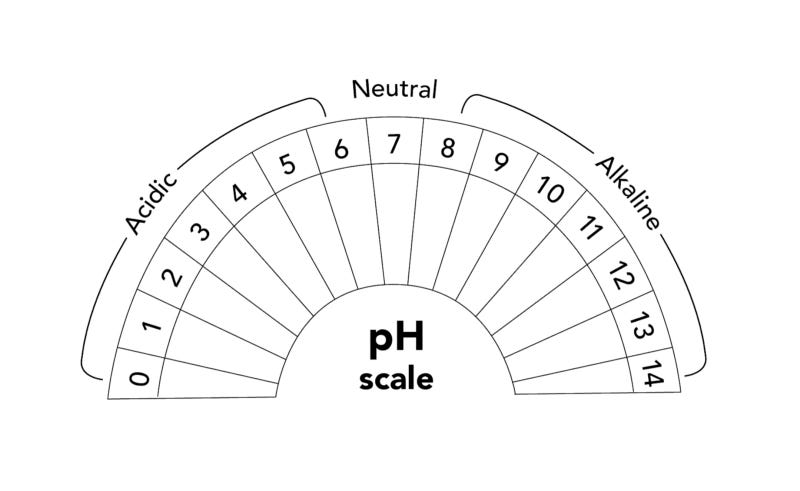How to Regulate Your pH Levels for Better Health
4 scientifically proven ways to boost health, balance hormonal levels, and create emotional stability using simple practices that can enhance daily life
At the age of 33 years old, Danish chemist Søren Peter Lauritz Sørensen was appointed head of Chemistry at the Carlsberg Laboratory in Copenhagen and was tasked with answering one burning question: How do you brew the best beer in the world?
Along with many other brewers, he began studying fermentation. This then led him to study the formation of amino acids, the building blocks of proteins, and then to enzymes made from proteins.
He quickly realised that hydrogen ion concentrations were important to how these enzymes performed functionally so he set about developing a way to keep track of these conditions in a solution.
The pH scale was born because it managed to take this complicated chemical phenomenon and distil it into an easy-to-grasp metric that any average person could understand.
It was so practical and universal that other industries began using it too. So much so that today it designs batteries, diagnoses blood disorders, and measures humanity’s impact on the oceans.
But what does it mean, exactly?
The term pH stands for the potential of hydrogen, and (in terms of health) it measures the acidity and alkalinity of the body. It ranges from 0 to 14 with the lowest number being the most acidic and the highest number being the most alkaline.
The ideal pH is somewhere in the middle between 7.35 and 7.45. This naturally keeps the body well balanced and when the body is well balanced, everything functions as it should.
Maintaining a healthy pH balance has multiple benefits. It:
Creates mental clarity
Builds emotional stability
Regulates mood and hormonal levels
Boosts energy levels
Encourages smooth digestion
Boosts the immune system
Lowers the risk of inflammation, infection, sickness, and disease
When the body’s pH levels become unbalanced, on the other hand, it is no longer in an optimal state. When this happens a number of unfortunate side effects can occur.
In the short term it can lead to constipation, bloating, low energy levels, mood swings, and tiredness but in the long-term inflammation and chronic fatigue can occur. Even autoimmune diseases and cancers can develop.
Here are a few things that can knock it out of balance:
Poor nutrition
Excessive alcohol and coffee consumption
Stress (emotional, mental, and environmental)
Trauma
EMF exposure
A lack of sleep and exercise
Medication/antibiotics
Unsupportive breathing habits
This is contributing to health conditions such as asthma to be on the rise, along with allergies, inflammation, anxiety, depression, chronic fatigue, and heart failure.
In fact, heart failure is the number killer in the U.S. as we speak.
Anxiety levels are also through the roof.
However “normal” these conditions have become, though, they’re a sure sign that the body, mind, and/or spirit are out of balance in at least one area or another.
The good news is that with a few simple adjustments, the body can come back into balance and these conditions can either be avoided, controlled, or reversed.
Here are a four ways to do just that.
The breath
The breath is made up of two parts — inhale (oxygen), exhale (carbon dioxide).
On the pH scale, oxygen is a neutral gas while carbon dioxide is acidic. That’s because carbon dioxide dissolves in water to form carbonic acid.
As our lungs and the brain are how the body regulates its pH levels from moment to moment (or breath to breath), the quality of the breath determines the quality of our lives.
If it becomes unbalanced, an ocean of side effects can begin to form.
If there’s too much oxygen through overbreathing, for example, or not enough because of laboured or shallow breathing, the body experiences two different states: respiratory alkalosis or respiratory acidosis.
Respiratory alkalosis is caused through breathing too deeply and/or too often and can be brought on by things like stress, breathing through the mouth, and/or poor health.
This begins to over-oxygenate the cells inside the body while depleting its carbon dioxide supply. This causes the pH of the blood to rise and become alkaline and if it remains that way for too long it can lead to stress, anxiety, depression, dizziness, nausea, numbness in the hands and feet, and muscle spasms.
Respiratory acidosis is its counterpart, and it happens for the opposite reasons. When not enough carbon dioxide is removed from the body it becomes “stale” or acidic.
This typically occurs from weaker, shallower breathing caused by pulmonary diseases such as emphysema and pulmonary fibrosis. It can also develop through obesity and asthma.
Fortunately, the general rule of thumb for maintaining a healthy pH balance with the breath is simple:
Breathe smooth, calm, consistent breaths in through the nose and breathe less.
This will help to keep things ever so slightly tipped toward the alkaline side (but not too much), somewhere in that 7.35–7.45 sweet spot.
Exercise
Even though exercise creates a build-up of lactic acid it’s offset by how much carbon dioxide and other toxins are removed during exhalation. So, the body becomes alkaline as a result.
Exercise also provides a low-dose jolt to the brain’s reward centres which are responsible for helping us anticipate pleasure. So, dopamine is released before, during, and after exercise along with oxytocin and serotonin.
This not only makes us feel good but keeps us motivated to keep doing it.
Regular exercise helps to build this reward system up over time which leads to higher circulating levels of dopamine and more available dopamine receptors.
So, even though we might feel tired or drained after a workout, we’ll typically feel calmer, more relaxed, energised, and clearer down the line.
20 minutes a day is plenty. As long as the body gets moving and the heart gets pumping and the blood gets flowing, and the breath gets breathing, the body will naturally become slightly more alkaline as a result.
Cool fact: 84% of weight loss happens through breathing!
“If you lose 10 pounds of fat, precisely 8.4 pounds comes out through your lungs and the remaining 1.6 pounds turns into water. In other words, nearly all the weight we lose is exhaled.” — CNN
And there ain’t no better way to breathe deeper and faster than some good old exercise.
Diet & Digestion
What we eat and how much we eat play a big role in the health of our digestive system, microbiome, and kidney functionality. Overeating is a big no-no. This puts the digestive system under pressure because it makes everything work harder.
It also creates a build-up of undigested food in the kidneys that then have to be filtered and processed. Over time, this can lead to pathogenic and bacterial overgrowth.
“Everything we put into our bodies — from foods and toxins to thoughts and feelings — can shift immune function at a base level.” — Jeffrey Rediger
A simple diet of fruit and veggies along with some supportive teas and green juices is a great way to maintain a healthy pH balance.
Fruits and veggies are packed with antioxidants and nutrients so they help to fight inflammation while keeping the body’s energy levels high. They’re also quick and easy to digest so the body can rest for longer.
Here are some of the most alkaline foods to get your teeth into:
Avocado
Kale
Sweet potato
Spinach
Garlic
Onion
Broccoli
Celery
Tofu
Nuts
Seeds
Fermented foods like sauerkraut and kimchi
Stress Management
When it comes to stress affecting the pH of the body, it’s all about what hormones are released by the nervous system in response to each stressor.
These stress hormones are adrenaline and cortisol and if they’re sustained over long periods of time, tension can arise, inflammation can occur, and our sleep, mood, energy levels, digestion, heart, emotional well-being, and relationships can all be affected.
This can then lead to an acidic residue as toxins are prevented from being removed as the heart and lungs are favoured over the digestive system and kidneys.
“Stress is one of the biggest causes of epigenetic change because it knocks your body out of balance. It comes in three forms: physical stress (trauma), chemical stress (toxins), and emotional stress (fear, worry, being overwhelmed, and so on). Each type can set off more than 1,400 chemical reactions and produce more than 30 hormones and neurotransmitters.” Dr. Joe Dispenza
Apart from breathwork, meditition, and regular exercise, another tool I lean on is brainwave music.
To date, brainwave music is being used to treat patients with ADD, depression, sleeping disorders, and anxiety, while also speeding up blood circulation, brain activity, and cognitive thinking in the elderly.
It’s even helping people with more severe conditions such as brain damage, stroke patients, and Parkinson’s disease.
This is happening, in part, because of the way brainwave music helps to ‘reorganise’ brainwave activity thus boosting proper brain functionality.
This is then opening people up to experience spontaneous healing because the body naturally wants to harmonise.
Harold Russell, a clinical psychologist, used sound therapy on his wife to help her recover from a severe stroke. “One day she told me the fog just went away.” He reported.
“We may be sitting on one of the most widely available and cost-effective therapeutic modalities that ever existed” — Turow
Here’s one of my all-time favourites:
Soma Breath — my favourite kind of breathwork — uses brainwave music as a fundamental component of their practice for these exact reasons. And from my own direct experience, I can highly recommend it. Combining specifically designed brainwave music with rhythmical breathing is very special indeed!


